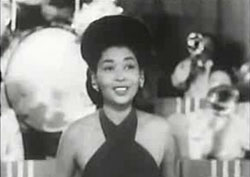 The International Sweethearts of Rhythm appeared in three Mills Panoram soundies, She's Crazy with the Heat (1947), That Man of Mine (1947), & How 'Bout that Jive (1947).
The International Sweethearts of Rhythm appeared in three Mills Panoram soundies, She's Crazy with the Heat (1947), That Man of Mine (1947), & How 'Bout that Jive (1947).
She's Crazy with the Heat is a medly of two songs, the second being "Jump Children."
Two extant reference books on soundies, conferring with one another on lists & copyright information without access to the films themselves, give these two songs as the titles of two separate soundies, while missing altogether the actual third soundie, How 'Bout that Jive, which is also a medley of two.
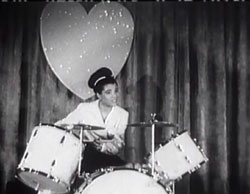 As She's Crazy with the Heat opens, the title number, a fine swing instrumental, begins with a bank of saxophones being mellow-swing, then shifting to a bank of trumbones & trumpets. As She's Crazy with the Heat opens, the title number, a fine swing instrumental, begins with a bank of saxophones being mellow-swing, then shifting to a bank of trumbones & trumpets.
The set is simple, bandboxes in front of a curtain, with a cut-out heart on each musician's box, & a bigger cut-out heart on the curtain behind them. The drummer is raised above the band in front of the curtain's heart.
There's a good piano solo by Johnnie Mae Rice, in front of the orchestra on the stage beside Anna Mae.
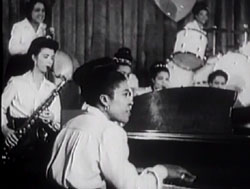 Johnnie Mae has got her hair up & this is a black piano, a point to bare in mind because not all the Sweetheart concert footage that survives was from the same session. There were three songs performed on this specific set, the third used for the soundie That Man of Mine. Johnnie Mae has got her hair up & this is a black piano, a point to bare in mind because not all the Sweetheart concert footage that survives was from the same session. There were three songs performed on this specific set, the third used for the soundie That Man of Mine.
After the big launch with banks of trumbones & trumpets, the instrumental goes to a solo by Violet Burnside on sax. She would later head up her own all-girl band, Vi Burnside & Her All Stars (the idea of "All Stars" traces back to Louis Armstrong's All Stars, & his buddy Jack Teagarden's All Stars). There's a photo of Vi & Her All Stars.
Vi is followed by a longer hence more exciting trumpet solo. I think that's Jean Starr. Then there's a nice if brief drum solo by Pauline Braddy, mostly her tomtoms, before the number closes. It's a fine instrumental for highlighting some of the best in the band.
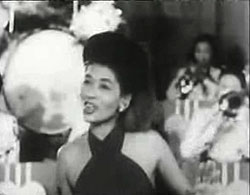 As soon as the number is done, Anna Mae speaks up, introducing the next number for which she will perform the vocal, a superior bit of Jordanesque jump-jazz called "Jump Children." The lyric runs: As soon as the number is done, Anna Mae speaks up, introducing the next number for which she will perform the vocal, a superior bit of Jordanesque jump-jazz called "Jump Children." The lyric runs:
"When you're feeling low & you don't know what to do/ When you're feeling low & you don't know what to do/ Just stay in the groove, let nothing bother you.
"I may be small but baby have no fear/ I may be small but baby have no fear/ I can climb a hill without shiftin' gears.
"I ain't good lookin' & I don't have waist-long hair/ I ain't good lookin' & I don't have waist-long hair/ But my mama gave me something that would take me anywhere.
"A rockin' chair to rock, a rubber ball to roll/ Takes a long tall daddy to satisfy my soul." The number is about to conclude, but includes a smidgen of call & response between Anna Mae & her musicians:
"Baby rock me with that jelly roll/ My baby rocks me with that jelly roll/ Do you wanna jump, children? (Yeah!)/ Do you wanna jump children? (Yeah!)/ Do you wanna jump children? (Yeah!)/ Do you wanna jump children? (Yeah!)/ Jump, jump, jump, jump."
Then that slim powerful-looking butch beauty Vi Burnside returns for one last sax solo before the soundie is concluded.
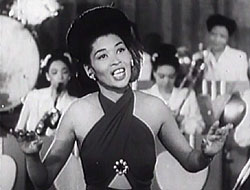 The stunningly, exotically beautiful Anna Mae Winburn sings the blues in the soundie That Man of Mine (1947), as frontwoman for the International Sweethearts of Rhythm, an absolutely fabulous all-girl orchestra. The stunningly, exotically beautiful Anna Mae Winburn sings the blues in the soundie That Man of Mine (1947), as frontwoman for the International Sweethearts of Rhythm, an absolutely fabulous all-girl orchestra.
The song was written by Maurice King who did quite a bit for the band. Anna Mae sings the straight blues lyrics without for a moment looking sad: "I feel so lonesome, I don't know what to do/ Yes I feel so lonesome I don't know what to do/ I need by man to tell my troubles to.
"Yes I love that man & I want him for myself/ Yes I love that man & I want him for my self/ I don't want that good treatment to go to nobody else.
"My baby used to love me each & every night/ No matter what he does yeah I've got to treat him right/ I love him, yes I love that man of mine/ When I think about him, I just can't keep from cryin'."
It's a sleepy, sensual interpretation. She stands in front of the band in dark evening gown, sleek as a cat, her hands usually raised for a smooth conducting sway of her arms.
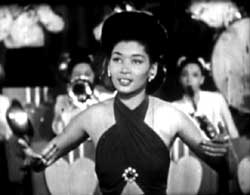 The instrumental arrangement is big-band swing though the vocal is more personal. The arrangement melds beautifully from vocal to instrumental break, when the entire band stands up in order to sway slowly from side to side & just make the greatest visual impact without overdoing -- subtle, dignified, & totally gorgeous. The instrumental arrangement is big-band swing though the vocal is more personal. The arrangement melds beautifully from vocal to instrumental break, when the entire band stands up in order to sway slowly from side to side & just make the greatest visual impact without overdoing -- subtle, dignified, & totally gorgeous.
As Anna Mae picks up the vocal anew, the song concludes: "When my baby left me, I fell on my knees &am pcried/ Yes when my baby left me, I fell on my knees & cried/ He got the kind of lovin' that leaves me always satisfied."
The International Sweethearts of Rhythm were founded in 1939 in Mississippi. Tennessee-born Anna Mae joined as conductor in 1941 & led the orchestra until it disbanded at decade's end. In the 1950s she attempted to reform the band from scratch, but the big band era was over. The new version of the orchestra was whittled down to an octet by 1955, just before it met its second demise.
When first hired to front the band, it was due to her extraordinary beauty & slender shapeliness. She hadn't been expected to be able to compose or perform all that much, but she fooled 'em by being a truly great talent on every level, driving ISR to unexpected heights of popularity.
Anna Mae already had in fact a lot of experience, as front-woman for "territorial" or regional women's bands around Mississippi. And just before taking over leadership of the Sweethearts she had been leading an otherwise all-male band out of Omaha, Nebraska, called The Cotton Club Boys, from which came the great bebop guitarist Charlie Christian.
At Washington, D.C.'s Howard Theater, the Sweethearts pulled weekly audiences of 35,000, breaking all attendance records. They'd get the kind of ovations usually reserved for leading baseball teams' home runs.
It's not often recalled today, but in fact all-girl bands were a commonplace in the 1940s. But few had recording contracts. Most were treated as novelty acts & not taken for the serious musicians they often were. During the war years when so many musicians were drafted, it became easier for the girl bands to get gigs, & ISR flourished for this little while.
By the reviews of their concerts that appeared in black community newspapers, it's obvious the Sweethearts were taken much more seriously than were the majority of women's bands, but still they never scored a recording contract due to the prejudices against women jazz performers.
They only ever recorded two songs for official record release. If not for a few transcriptions from the Jubilee black entertainment radio show, & the film footage produced by African American producer William D. Alexander (who also directed Burlesque in Harlem, 1954), there'd be scant opportunity today to see or hear this glorious & glamorous act.
After the war, the big band era was in any case fading away, the girl bands along with the rest. The International Sweethearts had been one of the first integrated girl orchestras with black, asian, & caucasian members, although they played mainly black venues.
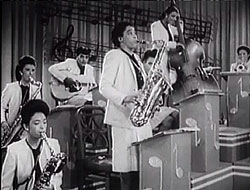 The soundie How 'Bout that Jive (1947) is a medley of two songs by the International Sweethearts of Rhythm. Big sax solo by Vi Burnside dominates the first number. The title of this number isn't given but it's "Vi's Vigour" as Violet Burnside is the number's star performer, & this was her signature number.
The soundie How 'Bout that Jive (1947) is a medley of two songs by the International Sweethearts of Rhythm. Big sax solo by Vi Burnside dominates the first number. The title of this number isn't given but it's "Vi's Vigour" as Violet Burnside is the number's star performer, & this was her signature number.
The orchestra is arrayed in front of a curtain with decorative musical notations. The gals' individual bandboxes have musical notes emblazoned front & sides. Raised above the orchestra on a pedestal is Lucille Dixon on slap bass.
For "Vi's Vigor," Anna Mae is dance-conducting with subtle grace as Vi stands in her bandbox with her sax & just keeps it jumping. This sax performance is damned close to pure bebop.
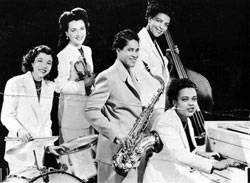 Anna Mae is dressed in a white gown, & this is a different set without the heart-curtain of the above two soundies. All three soundies were selections made from the half-hour film International Sweethearts of Rhythm (1947) consisting of three sessions filmed in 1946, initially for two one-reelers & a third film mixed in with other acts. Anna Mae is dressed in a white gown, & this is a different set without the heart-curtain of the above two soundies. All three soundies were selections made from the half-hour film International Sweethearts of Rhythm (1947) consisting of three sessions filmed in 1946, initially for two one-reelers & a third film mixed in with other acts.
The session in front of the heart-curtain & Anna Mae in black gown (for "She's Crazy for the Heat," "Jump Children," & "That Man of Mine" were earlier than the rest of the numbers, whether in 1945 or 1946 is hard to say. The bulk of the numbers were filmed in November 1946. These latter numbers have Anna Mae initially in a white gown (for the two numbers on this soundie, plus the excluded "I Left My Man" & "Don't Get Twisted"). For the third session she wears a pant-suit & then changes into the black gown she wore in the earlier footage.
In the three filmed sessions Anna Mae is in quite different general moods. In the earlier session represented in How 'Bout that Jive which has her dressed in white, she's smiling broadly & frequently bouncing up in down conveying great joy in the music. By contrast, in the session toward the end of the year before the heart-curtain, she is slightly more serious in black, with her arms very often raised upward at her side in a sort of trademark conducting pose. In either her joyful or serious moods & poses, she has amazing poise & grace.
The session of four numbers with the black piano & cut-out-heart bandboxes & curtain were first seen in the half hour film Love in Syncopation (1946). This is the film that guest-starred the Sweethearts but had as its lead act Henry Wood & His Sextet, together with dancers & guest singers. The footage with just the Sweethearts was later combined into the single half-hour concert film The International Sweethearts of Rhythm (1947) with all the other footage known to survive of the band, from the November '46 session, & select numers again divided up into still shorter soundies.
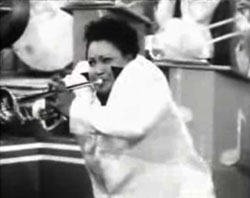 After "Vi's Vigor," for the second number in How 'Bout that Jive we get the title song. After "Vi's Vigor," for the second number in How 'Bout that Jive we get the title song.
Out runs a rotund singer who begins: "Mama's round & brown & can roll just lilke a ball/ Yes mama's round & brown & can roll just like a ball/ She's got a lot to give & daddy you can have it all."
This great performer is Ernestine "Tiny" Davis, who is indeed round & brown. She also recorded this number with her own band Tiny Davis & Her Orchestra, as it was her signature song.
Tiny a dyke & so were a couple other members of the band, inducing Maurice King to write for the Sweethearts a minor number called "Diggin' Dykes" which can be heard on the CD compilation Hot Licks, 1944-1946 collecting the band's surviving radio transcriptions from the program Jubilee aimed at black GIs.
Tiny's partner of forty years was drummer/pianist Ruby Lucas. They "star" together in a video interview Tiny & Ruby: Hell Divin' Women (1988), in which they reminisce about the International Sweethearts of Rhythm & women of the jazz community generally.
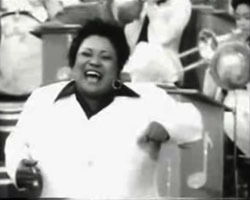 She continues, with a bit of call & response toward the end: "Don't worry 'bout it chillun cuz I've got it by the ton/ Don't worry 'bout it chillun cuz I've got it by the ton/ So buzz me buzz me baby cuz, here's where you get your fun. She continues, with a bit of call & response toward the end: "Don't worry 'bout it chillun cuz I've got it by the ton/ Don't worry 'bout it chillun cuz I've got it by the ton/ So buzz me buzz me baby cuz, here's where you get your fun.
"I'm sister five by five & I'm known all over town/ I'm sister five by five & I'm known all over town/ I ain't much when I stand but oh when I lay it down.
"Now when you pick your chicks, you pick 'em big & fat/ You can bet your boots at a sight like that/ How 'bout that jive? (All right, all right)/ How 'bout that jive? (All right, all right)/ How 'bout that jive? (All right, all right/ Daddy you can have it all.
"I eat enough to burst, enough to roll/ And what I've got will satisfy your soul/ I'm a king size mama with a king size apetite/ You got the key to my door if you know how to turn it right."
An instrumental break puts the trumpet in that big mama's hands & she blows the high notes for an exciting close.
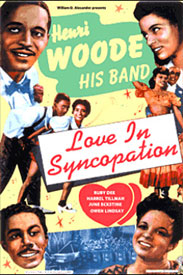 I feel I should footnote some comments on the short feature Love in Syncopation & the recycling of material from it other than the ISR performances. From it came two soundies starring the Henri Woode band, Adventure (1947), & written by Henri Broadway (1947). On these Henri's name is mispelled Henry. I feel I should footnote some comments on the short feature Love in Syncopation & the recycling of material from it other than the ISR performances. From it came two soundies starring the Henri Woode band, Adventure (1947), & written by Henri Broadway (1947). On these Henri's name is mispelled Henry.
Anna Mae Winburn & the International Sweethearts of Rhythm were also featured in Love in Syncopation, but it's the same footage of "Vi's Vigor," "Don't Get It Twisted," & Tiny Davis singing "How 'Bout that Jive."
Producer William Alexander re-edited all his half-hour films into numerous shorter films for the soundies market & for distribution as pre-feature shorts for urban theaters that catered largely to black audiences.
One of the Sweetheart's numbers in Love in Syncopation that became the soundie That Man of Mine is very often cited as being sung by the great stage & film actress Ruby Dee, which is by no means the case. It's obviously Anna Mae singing. Similarly, That Man of Mine pops up in Henri Woode filmographies, but he's not excerpted in the soundie.
A very young Ruby did have her first screen appearance in Love in Syncopation alongside another stage actor, Harrel G. Tilman, who later in life was elected mayor of Huston. The error that Ruby Dee sang for the Sweethearts first appeared in a book about women's jazz bands, & has often been repeated around the world wide web.
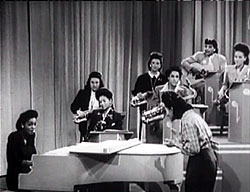 Harlem Jam Session (1949) should've been a soundie but the soundie era ended in 1947. Producer William Alexander's was still recycling footage his director Laurence Anderson & cinematographer Don Malkames had shot mostly in 1946.
Harlem Jam Session (1949) should've been a soundie but the soundie era ended in 1947. Producer William Alexander's was still recycling footage his director Laurence Anderson & cinematographer Don Malkames had shot mostly in 1946.
The numbers included in this one were the title instrumental "Harlem Jam Session" & two other instrumentals, "Don't Get It Twisted" & "Just the Thing."
These numbers were all from the November 1946 sessions, which in total had three costume changes for Anna Mae, & one slight redressing of the stage, the last numbers having different curtain decorations attached.
During the first song "Harlem Jam Session" Anna Mae changed out of the white gown seen in the soundies She's Crazy with the Heat & That Man of Mine & is now wearing a lightly checkered blouse & dark pants, at a time when only cowgirls & women orchestra leaders had the nerve to wear pants.
This is a fine instrumental arranged to give several key musicians solo moments. It opens as a display of the talents of Jean Starr on trumpet being comparatively melodic, followed by Johnnie Mae Rice with another Basie-esque piano riff, a drum solo by Pauline Braddy, & then Vi Burnside wailing on sax. In one good shot of Vi, you can see beyond her in the back the guitarist who has kept a steady beat throughout.
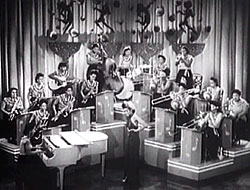 For the instrumental "Don't Get It Twisted," Anna Mae has changed gowns again. She's wearing the gown she'd worn in the older session when the band-boxes were the ones with heart cut-outs on the front & there was a heart on the curtain. But this is the later session with the musical-note bandboxes for each of the musicans. For the instrumental "Don't Get It Twisted," Anna Mae has changed gowns again. She's wearing the gown she'd worn in the older session when the band-boxes were the ones with heart cut-outs on the front & there was a heart on the curtain. But this is the later session with the musical-note bandboxes for each of the musicans.
The musical notes that were attached to the rear curtain during "Harlem Jam Session" (as well as earlier numbers from the soundies How 'Bout that Jive & She's Crazy with the Heat) have been taken off, & replaced with silhouettes of dancing gals.
Jean Starr gets another trumpet solo, then Johnnie Mae Rice's piano solo, & as so often, Vi gets an extended sax solo. These were the orchestra's biggest star musicians, & Vi the most famed of the three.
The third & final instrumental "Just the Thing" has the same stage arrangement with the dancing-girl silhouettes attached to the rear curtain, with the band arrayed in the same way as when the curtain had musical notes attached to it. But Anna Mae is now in her low-fronted black gown with the broach centered at her cleavage.
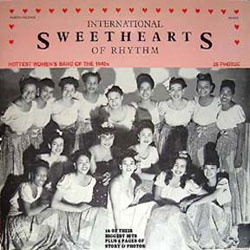 "Just the Thing" once more provides Johnny Mae Rice a good piano solo. Though she hunches a little old-ladyish over the keyboard, the camera delights no less in her strong young gorgeous profile. "Just the Thing" once more provides Johnny Mae Rice a good piano solo. Though she hunches a little old-ladyish over the keyboard, the camera delights no less in her strong young gorgeous profile.
The first half of this number really stars Johnny Mae, & the orchestra rarely plays over her. Roxanna Lucas on guitar keeps the steady beat more than do bassist Lucille & drummer Paula who are on the top of the pyramidal array of musicians.
A bank of saxophones leads into a long solo for Jean Starr's trumpet, which leads into a bank of trumbones which serve as a similar intro to Vi's sax solo. That journey from piano, to trumpet, to sax for these three stars of the show you'll begin to notice is IRS standard arrangement in several numbers. It all concludes with a somewhat Dorsey-esque blast.
Harlem Jam Session was one of several short subjects distributed to theaters by Alexanders' Transvideo Corp. of America. Their other films in the series were as follows:
1) Harlem After Midnight (1949) with Billy Eckstine & his orchestra, was condensed & edited from Rhythm in the Riff (1947). 2) Harlem Mood (1949) stars Henri Woode & His Sextet, excerpted from Love in Syncopation. (1947). 3) Harlem Carnival (1949) also featured selections from Love in Syncopation. And 4) Harlem Dynamite (1949) starring Dizzy Gilespie's Be-Bop Orchestra is derived from what may well be the most important film from William Alexander's production company, Jivin' in Be-Bop (1946).
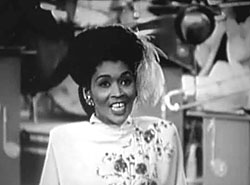 Among all the shorter films combined into The International Sweethearts of Rhythm there remains one number that is only in the half-hour film. That's "I Left My Man" sung by Anna May Winburn. She's wearing her white gown, & this performance followed Tiny Davis's "How 'Bout that Jive."
Among all the shorter films combined into The International Sweethearts of Rhythm there remains one number that is only in the half-hour film. That's "I Left My Man" sung by Anna May Winburn. She's wearing her white gown, & this performance followed Tiny Davis's "How 'Bout that Jive."
It starts with a solo by that gorgeous pianist, Johnnie Mae Rice. With an even beat from Lucille Dixon on bass, Johnnie Mae is at first doing a simple tinkling tune reminiscent of Count Basie when he's just getting started on something, & she then builds around that little rift for a fuller sound.
The similarity to Basie could well be due to the influence of Eddie Durham of the Count Basie Orchestra, who did a lot of arrangements for the Sweethearts (as well as for Jimmie Lunceford, Artie Shaw, Glenn Miller & other greats).
Durham helped whip the band in shape in 1941 just before they first set out on their own. He was working with them even before Anna Mae came on board. Even when Durham's assistance ended the band continued to use his charts for the arrangements, while adding new ones by his replacement Jesse Stone, then Maurice King.
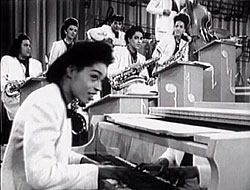 Before Johnnie Mae's piano solo could get wild, she reaches a plateau suitable to Anna Mae's vocal. "I Left My Man" isn't as tough a blues lyric as the title might imply, as it's told as an upbeat & temporary parting with Anna Mae's man waiting eagerly for her to return. The entire lyric runs: Before Johnnie Mae's piano solo could get wild, she reaches a plateau suitable to Anna Mae's vocal. "I Left My Man" isn't as tough a blues lyric as the title might imply, as it's told as an upbeat & temporary parting with Anna Mae's man waiting eagerly for her to return. The entire lyric runs:
"I left my baby standing on the railroad track/ Yes I left my baby standing on a railroad track/ He said you know I love you, I'll stay 'til you get back.
"He's tall & terrific, yes & he's so refined/ Yes he's tall & terrific, yes & he's so refined/ Everytime I have to leave him I'll have to change my mind.
"He's mine all mine I'll tell the world he is/ Yes he's mine all mine I'll tell teh world he is/ He treats me so fine everything I've got is his."
A full orchestral instrumental follows. Vi stands up for what appears to be a sax solo, but then Tiny blasts high-notes at fellow trumpeter Jean Starr, putting on quite a show for the final moments of the song.
Tiny was a star in her own right. The Sweethearts played the Apollo Theater on five occasions, & each time other bandleaders would be waiting in the wings in some cases hoping to hire one of the girls away from the Sweethearts.
Louis Armstrong atempted to win away Tiny offering a vastly higher salary, ten times what she was making. It would frankly be a step up professionally as well as financially, but Tiny couldn't bare to leave the Sweethearts, for as she said in Tiny & Ruby: Hell Divin' Women, "I loved them gals too much. Them was some sweet gals."
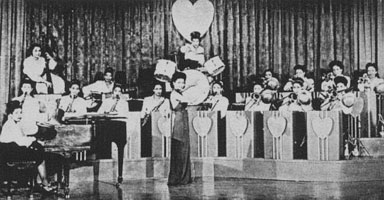 So that's it, a discription of each & all of the numbers that have come down to us from this tremendous orchestra.
So that's it, a discription of each & all of the numbers that have come down to us from this tremendous orchestra.
Though often treated as a novelty in their day & not given recording contracts, we see by the filmed performances how seriously unjust that was. They were part of the cutting edge of the new bepob & were the equal of the top jazz musicians of the forties.
And the Sweethearts well knew they were as good as the best male orchestras. Some of the members just outright asserted they were better than most male bands, because they were.
Yet despite the high quality of their musicianship, their beauty & spirit, they were paid half what men would've gotten for gigs, & they only ever recorded two records officially. The rest that survives of their music are the radio transciptions, & the few filmed numbers.
As young women on the road they faced other problems, too, racism atop the sexism making their path a double-whammy of difficulties. They were the first nationally known integrated women's band, including black, Hawaiian, Asian, Mexican, Native American, & white musicians.
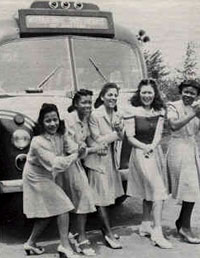 Anna Mae years later spoke of their tour bus in the South harrassed by police because there were white women in the band. In one case the driver became so frightened for his life he didn't want to drive the bus anymore. Anna Mae years later spoke of their tour bus in the South harrassed by police because there were white women in the band. In one case the driver became so frightened for his life he didn't want to drive the bus anymore.
Anna Mae left the bus with the the two white women, saxophonist Rosalind "Roz" Cron, a Jewish gal from Boston, & trumpeter "Little Toby" Butler. The three of them laid on the floor of a taxi, white a cabby as frightened as the bus driver had been raced to the train station.
You'll look to no avail for Toby & Roz in the filmed performances. Had they been on screen, distribution of a mixed-race concert film would've been much more difficult.
There were many all-girl bands during the war, & a few others were integrated. Toby also played for another mostly-black band, the "Darlings of Rhythm," for which she was the only white woman traveling with black women on gigs in the south. In Sherrie Tucker's book Swing Shift: All Girl Bands of the 1940s (2000) we get a story from another of the band members, Violet Wilson, who was arrested with Toby due to Jim Crow laws:
Toby & a couple other girls were put in the back seat of a police car for the crime of integration. She whispered to Violet that she well knew the police raped white women who travelled with black, just like they raped black women.
"I'll never let them take me." The officer hadn't searched her, so didn't know she had a .38 pistol in her purse. "They'll never do that to me. I'm going to blow him away." Fortunately trumbonist Jessie Turner convinced the cops that Toby was her cousin, a "yaller gal" rather than white, & they were let go.
It will be noticed that in the filmed performaces, white & Asian members of the band are missing, as there were many theaters that would not show an integrated film. They may well still be on the soundtrack, it's hard to know, but they had to be kept off camera.
copyright © by Paghat the Ratgirl
|
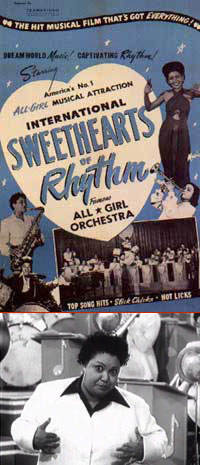

 As She's Crazy with the Heat opens, the title number, a fine swing instrumental, begins with a bank of saxophones being mellow-swing, then shifting to a bank of trumbones & trumpets.
As She's Crazy with the Heat opens, the title number, a fine swing instrumental, begins with a bank of saxophones being mellow-swing, then shifting to a bank of trumbones & trumpets. Johnnie Mae has got her hair up & this is a black piano, a point to bare in mind because not all the Sweetheart concert footage that survives was from the same session. There were three songs performed on this specific set, the third used for the soundie That Man of Mine.
Johnnie Mae has got her hair up & this is a black piano, a point to bare in mind because not all the Sweetheart concert footage that survives was from the same session. There were three songs performed on this specific set, the third used for the soundie That Man of Mine. As soon as the number is done, Anna Mae speaks up, introducing the next number for which she will perform the vocal, a superior bit of Jordanesque jump-jazz called "Jump Children." The lyric runs:
As soon as the number is done, Anna Mae speaks up, introducing the next number for which she will perform the vocal, a superior bit of Jordanesque jump-jazz called "Jump Children." The lyric runs:
 The instrumental arrangement is big-band swing though the vocal is more personal. The arrangement melds beautifully from vocal to instrumental break, when the entire band stands up in order to sway slowly from side to side & just make the greatest visual impact without overdoing -- subtle, dignified, & totally gorgeous.
The instrumental arrangement is big-band swing though the vocal is more personal. The arrangement melds beautifully from vocal to instrumental break, when the entire band stands up in order to sway slowly from side to side & just make the greatest visual impact without overdoing -- subtle, dignified, & totally gorgeous.
 Anna Mae is dressed in a white gown, & this is a different set without the heart-curtain of the above two soundies. All three soundies were selections made from the half-hour film International Sweethearts of Rhythm (1947) consisting of three sessions filmed in 1946, initially for two one-reelers & a third film mixed in with other acts.
Anna Mae is dressed in a white gown, & this is a different set without the heart-curtain of the above two soundies. All three soundies were selections made from the half-hour film International Sweethearts of Rhythm (1947) consisting of three sessions filmed in 1946, initially for two one-reelers & a third film mixed in with other acts.
 She continues, with a bit of call & response toward the end: "Don't worry 'bout it chillun cuz I've got it by the ton/ Don't worry 'bout it chillun cuz I've got it by the ton/ So buzz me buzz me baby cuz, here's where you get your fun.
She continues, with a bit of call & response toward the end: "Don't worry 'bout it chillun cuz I've got it by the ton/ Don't worry 'bout it chillun cuz I've got it by the ton/ So buzz me buzz me baby cuz, here's where you get your fun. I feel I should footnote some comments on the short feature Love in Syncopation & the recycling of material from it other than the ISR performances. From it came two soundies starring the Henri Woode band, Adventure (1947), & written by Henri Broadway (1947). On these Henri's name is mispelled Henry.
I feel I should footnote some comments on the short feature Love in Syncopation & the recycling of material from it other than the ISR performances. From it came two soundies starring the Henri Woode band, Adventure (1947), & written by Henri Broadway (1947). On these Henri's name is mispelled Henry.
 For the instrumental "Don't Get It Twisted," Anna Mae has changed gowns again. She's wearing the gown she'd worn in the older session when the band-boxes were the ones with heart cut-outs on the front & there was a heart on the curtain. But this is the later session with the musical-note bandboxes for each of the musicans.
For the instrumental "Don't Get It Twisted," Anna Mae has changed gowns again. She's wearing the gown she'd worn in the older session when the band-boxes were the ones with heart cut-outs on the front & there was a heart on the curtain. But this is the later session with the musical-note bandboxes for each of the musicans. "Just the Thing" once more provides Johnny Mae Rice a good piano solo. Though she hunches a little old-ladyish over the keyboard, the camera delights no less in her strong young gorgeous profile.
"Just the Thing" once more provides Johnny Mae Rice a good piano solo. Though she hunches a little old-ladyish over the keyboard, the camera delights no less in her strong young gorgeous profile.
 Before Johnnie Mae's piano solo could get wild, she reaches a plateau suitable to Anna Mae's vocal. "I Left My Man" isn't as tough a blues lyric as the title might imply, as it's told as an upbeat & temporary parting with Anna Mae's man waiting eagerly for her to return. The entire lyric runs:
Before Johnnie Mae's piano solo could get wild, she reaches a plateau suitable to Anna Mae's vocal. "I Left My Man" isn't as tough a blues lyric as the title might imply, as it's told as an upbeat & temporary parting with Anna Mae's man waiting eagerly for her to return. The entire lyric runs:
 Anna Mae years later spoke of their tour bus in the South harrassed by police because there were white women in the band. In one case the driver became so frightened for his life he didn't want to drive the bus anymore.
Anna Mae years later spoke of their tour bus in the South harrassed by police because there were white women in the band. In one case the driver became so frightened for his life he didn't want to drive the bus anymore.